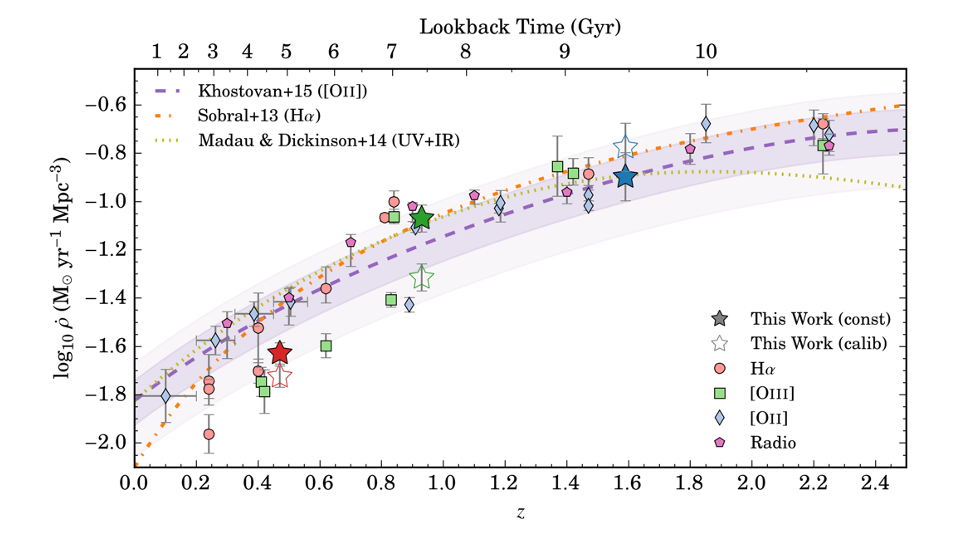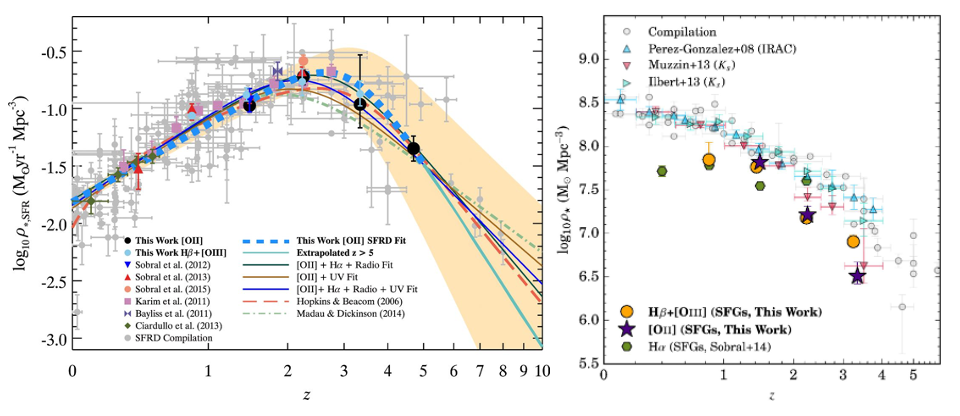Cosmic Star Formation History & Stellar Mass Build-up
Research | | Links: HiZELS Catalog | HiZELS SFRD | HiZELS SMD | LAGER SFRD

Cosmic Star Formation Rate Density Evolution from the LAGER survey Khostovan 2020. The trends clearly shows an order of magnitude drop in the average star formation activity occuring in the Universe such that galaxies are not as active as they once were 11 Gyrs ago. In a sense, the Universe is suffering a GDP crisis.
The cosmic star formation rate density (SFRD) evolution is one of the most fundamental property in all of extragalactic astrophysics as embedded within it are all the physical processes that are associated with how galaxies form stars and grow to become the structures that we see today. These are typically measured by first defining a sample of star-forming galaxies, measure their luminosity functions (distribution in terms of their brightness/star formation activity), and integrate the luminosity functions coupled with dust prescriptions and star formation rate calibrations. I led 2 studies measuring the cosmic star formation rate density for Hα, [OIII], and [OII] emitters up to \(z \sim 5\) using samples I created from HiZELS (Paper I) and LAGER (Paper II) narrowband imaging. The above figure is my measurement using the LAGER survey where we found consistency with past measurements and also noted that Hα SFRDs are typically lower compared to other tracers (e.g., radio which is unsusceptible to dust). This could potentially be due to underestimation in dust extinction at lower redshifts fro Hα samples (higher than the typical used \(A_{\rm{H}\alpha} \sim 1\) mag)
 Left: The cosmic SFRD evolution as measured with HiZELS ELG samples from Khostovan et al. (2015). Right: Cosmic stellar mass density evolution from Khostovan et al. (2016)
Left: The cosmic SFRD evolution as measured with HiZELS ELG samples from Khostovan et al. (2015). Right: Cosmic stellar mass density evolution from Khostovan et al. (2016)
I also investigated the cosmic SFRD out to \(z \sim 5\) using [OII] emitters and \(z \sim 3\) using [OIII] emitters in Paper I). We confirmed a peak in cosmic SFRD at \(z \sim 2 - 3\) and placed (at the time) the first non-UV/dropout measured SFRDs at \(z > 3\) to constrain the rapid \(\sim 2\) Gyr rise in cosmic star formation. We also found that [OIII]-measured star formation activity was consistent with other tracers providing evidence that [OIII] (classically used as a tracer of AGN) could be a reliable tracer of star formation activity.
I also invesigated the cosmic stellar mass density evolution in my in my 2016 paper. The cosmic stellar mass density essentially tells us how rapidly galaxies build-up their stellar mass and also can be used to measure fractions of star-forming galaxies in comparison to the global stellar mass density evolution. One key result of this work was that [OIII] reliably traced the bulk of the star-forming population. The same was true for [OII]-selected emitters except at \(z \sim 3\) which only traced \(\sim 40\%\) of the bulk of star-forming galaxies. Taking into account the changing ISM conditions with increasing redshift suggests this is evidence for higher [OIII]/[OII] ratios implying weaker [OII] emission from galaxies with increasing redshift (supported now by recent JWST spectroscopic observations).
